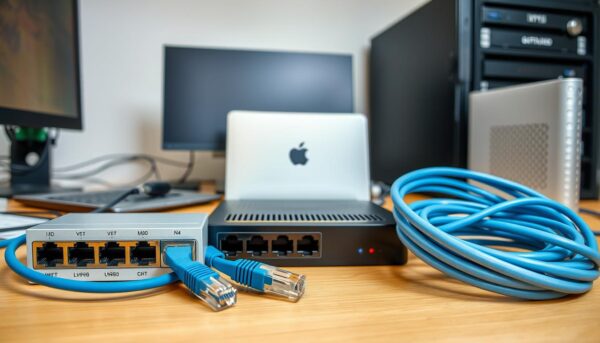✅ Last checked on
Ever wondered how office computers share files so fast or how home devices connect easily? It’s all thanks to Local Area Networks (LANs). This tech is key to modern connectivity, but what is a LAN and why is it so important?
A LAN connects computers and devices in a small area, like your home or office. It’s like digital glue that lets devices talk to each other quickly. With LANs, data moves fast, from 100 Mbps to 100 Gbps in some cases.
About 90% of businesses use LANs for internal talks. These networks are so vital that the global LAN market is set to hit $45 billion by 2030. LANs work for small home offices or big corporate spaces, supporting 2 to thousands of users.
In this guide, we’ll explore LANs, their types, parts, and how they keep our digital world running. Ready to learn about network connectivity? Let’s start!
Key Takeaways
- LANs connect devices within a limited area for fast data sharing
- They can serve from 2 to thousands of users in various settings
- LAN speeds range from 100 Mbps to 100 Gbps
- 90% of businesses use LANs for internal communication
- The global LAN market is projected to reach $45 billion by 2030
- LANs significantly improve operational efficiency in organizations
- Both wired and wireless LAN options are available for versatile connectivity
What is a Local Area Network (LAN)?
A Local Area Network (LAN) connects devices in a small area. This lets your computers, printers, and other devices talk and work together smoothly. Let’s explore what LANs are and their main parts.
Basic Definition and Purpose
LANs link computers in places like homes, offices, or schools. They help share data quickly and efficiently. For instance, you can print from your laptop to a printer in another room or access shared files.
Key Components of a LAN
Knowing the parts of a LAN helps understand how it works. Here are the key elements:
- Network adapters: Let devices join the network
- Switches: Manage data flow between devices
- Routers: Link different networks and control data
- Cables: Make physical connections (like Ethernet cables)

Network Architecture Overview
The network architecture shows how devices are set up and connected. Today, most LANs use a star topology. This means all devices connect to a central hub or switch. It improves performance and makes fixing problems easier than older setups.
| LAN Technology | Speed | Common Use |
|---|---|---|
| Ethernet | 10 Mbps – 10 Gbps | Wired office networks |
| Wi-Fi (802.11ac) | Up to 3.46 Gbps | Wireless home networks |
| Fiber Optic | 1 Gbps – 100 Gbps | High-speed data centers |
By learning these basics, you’re getting a good start on understanding LAN technology. It’s key to how we use technology every day.
Types of LAN Networks
Local Area Networks come in various forms to suit different needs. Let’s explore the main network types you might encounter in your home or office.
Wired LAN Networks
Wired LANs use Ethernet cables to connect devices. They offer high speeds and reliability, making them ideal for businesses that need constant, fast connections. Modern wired LANs can reach speeds of 100 to 1000 Mbps, a huge leap from early LANs that operated at 4 to 16 Mbps.

Wireless LAN (WLAN)
Wireless LANs use radio waves to connect devices without cables. They’re flexible and easy to set up, perfect for homes and offices where mobility is key. WLANs have come a long way, now offering speeds comparable to wired networks in many cases.
Virtual LAN (VLAN)
VLANs are logical networks created within a physical network. They help organize and secure network traffic by grouping devices logically, regardless of their physical location. This improves network performance and security.
| Network Type | Connection Method | Speed Range | Best For |
|---|---|---|---|
| Wired LAN | Ethernet Cables | 100-1000 Mbps | High-speed, stable connections |
| Wireless LAN | Radio Waves | Up to 1000 Mbps | Flexibility and mobility |
| Virtual LAN | Logical Grouping | Varies | Network organization and security |
Each network type has its strengths. Your choice depends on your specific needs. Whether it’s the high speed of a wired LAN, the flexibility of a wireless LAN, or the organizational benefits of a VLAN.
LAN Network Topologies
Network topology is how devices connect in a LAN. Let’s look at the main types and their effects on network performance.
Star Topology
Star topology is common in homes and offices. It connects all devices to a central hub or switch. This setup is reliable and easy to troubleshoot.
If one link fails, the rest of the network stays up. Star networks need N cables for N devices. Each device uses one port to connect to the hub.
Ring Topology
Ring topology connects devices in a circle. Data travels from one device to the next until it reaches its destination. It’s less common today but still used in some setups.
In a ring network with N devices, data must pass through N-1 nodes to reach the last one. Token passing is the usual access method in ring topologies.
Mesh Topology
Mesh topology connects each device to multiple others. In a full mesh, every device links to every other device. This creates multiple data paths, ensuring the network stays up even if some connections fail.
For N devices in a mesh, each needs N-1 ports. The total number of links is N(N-1)/2.
Bus Topology
Bus topology uses a single cable, or “bus,” to connect all devices. It’s simple and cost-effective for small networks. Bus networks support data rates up to 10 Mbps.
To connect N devices, you need one backbone cable plus N drop lines. Bus topologies are less common in modern networks due to potential network congestion.
Tree Topology
Tree topology branches out like a tree, connecting multiple star networks. It’s great for large, hierarchical networks and allows easy expansion. This structure is often used in big organizations to mirror management levels.
Tree topologies make it simple to add new devices, helping networks grow smoothly.
Understanding these network topologies helps you choose the best setup for your LAN. Each has its strengths, impacting network speed, reliability, and scalability. Consider your needs carefully when designing your network.
Setting Up a LAN Network
Are you ready to create your own Local Area Network? Let’s explore the basics of LAN setup. A well-organized network can help avoid problems and make fixing them easier. This is key for keeping your network running smoothly.
Required Hardware Components
To begin your LAN setup, you’ll need some essential hardware. You’ll need a router, a network switch, Ethernet cables, and network adapters for your devices. Make sure Ethernet cables are no longer than 100 meters to prevent signal loss.
Network Configuration Steps
First, connect your devices to your router or switch. Give static IP addresses to servers and network devices, and dynamic ones to workstations through DHCP. Also, set up sharing permissions and use VLANs to boost performance and security.
Troubleshooting Common Issues
When you run into network problems, follow these steps:
- Check all physical connections
- Verify IP address settings
- Update device firmware regularly
- Use network monitoring tools like Wireshark
Did you know 60% of users face connectivity issues with multiple devices on one router? Keep this in mind when setting up and troubleshooting your LAN.
LAN Security Essentials
Keeping your LAN safe from threats is key today. We’ll look at network security, common dangers, and how to protect your local network.
Common Security Threats
LANs face many security issues. Insider threats, weak spots, and malware are big risks. Open ports and unauthorized access points let attackers in. Most breaches come from human mistakes, showing the importance of constant learning.
Security Best Practices
Follow these steps to boost your LAN’s security:
- Use strong passwords and multi-factor authentication
- Regularly update and patch systems
- Segment your network to limit potential breach impacts
- Encrypt sensitive data
- Employ firewalls and antivirus software
- Secure wireless networks with WPA3 encryption
Network Monitoring Tools
Use network monitoring tools to catch and handle threats fast. IDPS can cut down response time by 50%. Regular security checks can find weaknesses and boost your security by 40%.
| Security Measure | Effectiveness |
|---|---|
| Multi-Factor Authentication | Reduces unauthorized access risk by 99.9% |
| Network Segmentation | Reduces potential breach impacts by 70% |
| Firewall Configuration | Blocks 85% of external threats |
| Data Encryption | Decreases data breach risk by 80% |
By using these security steps and staying alert, you can greatly lower LAN breach risks. This protects your important data and resources.
Benefits and Limitations of LAN Networks
LAN networks bring many benefits to homes and businesses. One big LAN benefit is sharing resources. This means many users can use one printer or scanner, saving up to 50% on hardware costs. It also saves on software licensing, with up to 30% savings due to shared use.
LANs also make managing data easier. This leads to fewer data loss incidents, with a 40% drop when using one server. They make data transfer faster, up to 100 times quicker than old methods.
But, LANs have their downsides. They are limited by geography, usually staying within one building or campus. This makes them less useful for big, spread-out organizations. Setting up a LAN can cost between $1,000 and $10,000, based on size and complexity.
Maintenance also takes a lot of time. IT staff might spend 15-20% of their year on upkeep and fixing problems. Security is another big issue. Without good security, 70% of data breaches come from inside. A failed server can stop all devices from accessing the network, showing how important server reliability is.
While LANs have many benefits, knowing their limitations is key. This helps in setting them up and managing them well.
Conclusion
As we finish our LAN overview, it’s clear that Local Area Networks are key in our digital lives. You’ve seen how LANs link devices in small areas, making data sharing fast and efficient. They help us work together better in homes and offices.
LANs are cost-effective and easy to manage. They transfer data much faster than Wide Area Networks. This makes sharing files quick and accessing resources easy. Plus, they have strong security features like firewalls to keep your data safe.
The future of LANs looks bright, with new technologies on the horizon. Wireless tech like Wi-Fi has already changed LANs, making them more flexible. Keep an eye on new network tech and how it will change LANs.
The world of networking is always changing. Whether you’re setting up a home network or managing a business LAN, you now have a good start. Keep learning and exploring as LANs continue to shape our connected world.